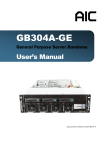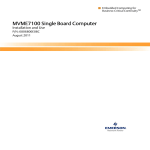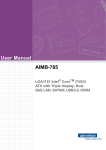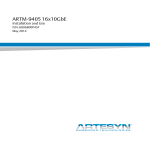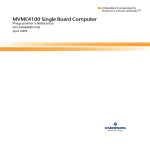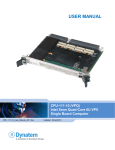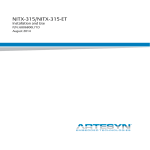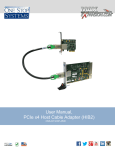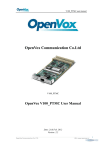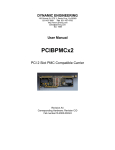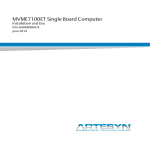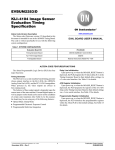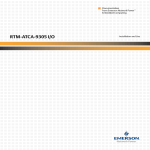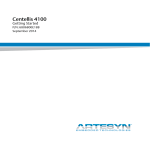Download XMCSPAN Installation and Use - Artesyn Embedded Technologies
Transcript
XMCSPAN Installation and Use P/N: 6806800H03C June 2014 © Copyright 2014 Artesyn Embedded Technologies, Inc. All rights reserved. Trademarks Artesyn Embedded Technologies, Artesyn and the Artesyn Embedded Technologies logo are trademarks and service marks of Artesyn Embedded Technologies, Inc.© 2014 Artesyn Embedded Technologies, Inc. All other product or service names are the property of their respective owners. Intel® is a trademark or registered trademark of Intel Corporation or its subsidiaries in the United States and other countries. Java™ and all other Java-based marks are trademarks or registered trademarks of Oracle America, Inc. in the U.S. and other countries. Microsoft®, Windows® and Windows Me® are registered trademarks of Microsoft Corporation; and Windows XP™ is a trademark of Microsoft Corporation. PICMG®, CompactPCI®, AdvancedTCA™ and the PICMG, CompactPCI and AdvancedTCA logos are registered trademarks of the PCI Industrial Computer Manufacturers Group. UNIX® is a registered trademark of The Open Group in the United States and other countries. Notice While reasonable efforts have been made to assure the accuracy of this document, Artesyn assumes no liability resulting from any omissions in this document, or from the use of the information obtained therein. Artesyn reserves the right to revise this document and to make changes from time to time in the content hereof without obligation of Artesyn to notify any person of such revision or changes. Electronic versions of this material may be read online, downloaded for personal use, or referenced in another document as a URL to an Artesyn website. The text itself may not be published commercially in print or electronic form, edited, translated, or otherwise altered without the permission of Artesyn. It is possible that this publication may contain reference to or information about Artesyn products (machines and programs), programming, or services that are not available in your country. Such references or information must not be construed to mean that Artesyn intends to announce such Artesyn products, programming, or services in your country. Limited and Restricted Rights Legend If the documentation contained herein is supplied, directly or indirectly, to the U.S. Government, the following notice shall apply unless otherwise agreed to in writing by Artesyn. Use, duplication, or disclosure by the Government is subject to restrictions as set forth in subparagraph (b)(3) of the Rights in Technical Data clause at DFARS 252.227-7013 (Nov. 1995) and of the Rights in Noncommercial Computer Software and Documentation clause at DFARS 252.227-7014 (Jun. 1995). Contact Address Artesyn Embedded Technologies Artesyn Embedded Technologies Marketing Communications Lilienthalstr. 17-19 2900 S. Diablo Way, Suite 190 85579 Neubiberg/Munich Tempe, Arizona 85282 Germany Contents About this Manual . . . . . . . . . . . . . . . . . . . . . . . . . . . . . . . . . . . . . . . . . . . . . . . . . . . . . . . . . . . . . . . . . . . . . . . . 9 1 Introduction . . . . . . . . . . . . . . . . . . . . . . . . . . . . . . . . . . . . . . . . . . . . . . . . . . . . . . . . . . . . . . . . . . . . . . . . . 13 1.1 1.2 1.3 2 Hardware Preparation and Installation . . . . . . . . . . . . . . . . . . . . . . . . . . . . . . . . . . . . . . . . . . . . . . . . . 17 2.1 2.2 2.3 2.4 2.5 2.6 2.7 3 Reset Sources . . . . . . . . . . . . . . . . . . . . . . . . . . . . . . . . . . . . . . . . . . . . . . . . . . . . . . . . . . . . . . . . . . . . . . 31 Controls, LEDs, and Connectors . . . . . . . . . . . . . . . . . . . . . . . . . . . . . . . . . . . . . . . . . . . . . . . . . . . . . . . . 33 4.1 4.2 4.3 5 Overview . . . . . . . . . . . . . . . . . . . . . . . . . . . . . . . . . . . . . . . . . . . . . . . . . . . . . . . . . . . . . . . . . . . . . . . . . . 17 2.1.1 Environmental Considerations . . . . . . . . . . . . . . . . . . . . . . . . . . . . . . . . . . . . . . . . . . . . . . . . 17 Power Requirements . . . . . . . . . . . . . . . . . . . . . . . . . . . . . . . . . . . . . . . . . . . . . . . . . . . . . . . . . . . . . . . . 18 2.2.1 Backplane Power Requirements. . . . . . . . . . . . . . . . . . . . . . . . . . . . . . . . . . . . . . . . . . . . . . . . 19 Checking the Box Contents . . . . . . . . . . . . . . . . . . . . . . . . . . . . . . . . . . . . . . . . . . . . . . . . . . . . . . . . . . 20 Installing a Mezzanine Card . . . . . . . . . . . . . . . . . . . . . . . . . . . . . . . . . . . . . . . . . . . . . . . . . . . . . . . . . . 20 Installing the Primary XMCspan . . . . . . . . . . . . . . . . . . . . . . . . . . . . . . . . . . . . . . . . . . . . . . . . . . . . . . 23 Installing the Secondary XMCspan . . . . . . . . . . . . . . . . . . . . . . . . . . . . . . . . . . . . . . . . . . . . . . . . . . . . 26 Removing the XMCspan . . . . . . . . . . . . . . . . . . . . . . . . . . . . . . . . . . . . . . . . . . . . . . . . . . . . . . . . . . . . . 28 Resetting the XMCspa . . . . . . . . . . . . . . . . . . . . . . . . . . . . . . . . . . . . . . . . . . . . . . . . . . . . . . . . . . . . . . . . 31 3.1 4 Features . . . . . . . . . . . . . . . . . . . . . . . . . . . . . . . . . . . . . . . . . . . . . . . . . . . . . . . . . . . . . . . . . . . . . . . . . . . 13 Standard Compliances . . . . . . . . . . . . . . . . . . . . . . . . . . . . . . . . . . . . . . . . . . . . . . . . . . . . . . . . . . . . . . 14 Ordering Information . . . . . . . . . . . . . . . . . . . . . . . . . . . . . . . . . . . . . . . . . . . . . . . . . . . . . . . . . . . . . . . 16 Board Layout . . . . . . . . . . . . . . . . . . . . . . . . . . . . . . . . . . . . . . . . . . . . . . . . . . . . . . . . . . . . . . . . . . . . . . . 33 Face Plate . . . . . . . . . . . . . . . . . . . . . . . . . . . . . . . . . . . . . . . . . . . . . . . . . . . . . . . . . . . . . . . . . . . . . . . . . 34 Connectors . . . . . . . . . . . . . . . . . . . . . . . . . . . . . . . . . . . . . . . . . . . . . . . . . . . . . . . . . . . . . . . . . . . . . . . . 36 4.3.1 VME Connectors . . . . . . . . . . . . . . . . . . . . . . . . . . . . . . . . . . . . . . . . . . . . . . . . . . . . . . . . . . . . . 36 4.3.2 LED Information . . . . . . . . . . . . . . . . . . . . . . . . . . . . . . . . . . . . . . . . . . . . . . . . . . . . . . . . . . . . . 38 Functional Description . . . . . . . . . . . . . . . . . . . . . . . . . . . . . . . . . . . . . . . . . . . . . . . . . . . . . . . . . . . . . . . . 41 5.1 5.2 5.3 Overview . . . . . . . . . . . . . . . . . . . . . . . . . . . . . . . . . . . . . . . . . . . . . . . . . . . . . . . . . . . . . . . . . . . . . . . . . . 41 Block Diagram . . . . . . . . . . . . . . . . . . . . . . . . . . . . . . . . . . . . . . . . . . . . . . . . . . . . . . . . . . . . . . . . . . . . . 41 PEX8533 PCI Express Switch . . . . . . . . . . . . . . . . . . . . . . . . . . . . . . . . . . . . . . . . . . . . . . . . . . . . . . . . . 42 XMCSPAN Installation and Use (6806800H03C) 3 Contents Contents 5.4 5.5 5.6 5.7 5.8 5.9 5.10 5.11 5.12 5.13 5.14 A PEX8533 Station and Port Configuration . . . . . . . . . . . . . . . . . . . . . . . . . . . . . . . . . . . . . . . . . . . . . . 42 XMCspan Stacking . . . . . . . . . . . . . . . . . . . . . . . . . . . . . . . . . . . . . . . . . . . . . . . . . . . . . . . . . . . . . . . . . . 42 Mezzanine Card Sites . . . . . . . . . . . . . . . . . . . . . . . . . . . . . . . . . . . . . . . . . . . . . . . . . . . . . . . . . . . . . . . 42 Mezzanine Card Identification . . . . . . . . . . . . . . . . . . . . . . . . . . . . . . . . . . . . . . . . . . . . . . . . . . . . . . . . 43 XMC.3 Support . . . . . . . . . . . . . . . . . . . . . . . . . . . . . . . . . . . . . . . . . . . . . . . . . . . . . . . . . . . . . . . . . . . . . 43 PMC AND PRPMC Support . . . . . . . . . . . . . . . . . . . . . . . . . . . . . . . . . . . . . . . . . . . . . . . . . . . . . . . . . . . 43 PCI Buses . . . . . . . . . . . . . . . . . . . . . . . . . . . . . . . . . . . . . . . . . . . . . . . . . . . . . . . . . . . . . . . . . . . . . . . . . . 44 TSI384 PCI EXPRESS-TO-PCI/PCI-X Bridge . . . . . . . . . . . . . . . . . . . . . . . . . . . . . . . . . . . . . . . . . . . . . . 44 Serial EEPROM For VPD . . . . . . . . . . . . . . . . . . . . . . . . . . . . . . . . . . . . . . . . . . . . . . . . . . . . . . . . . . . . . . 44 Clocking Scheme . . . . . . . . . . . . . . . . . . . . . . . . . . . . . . . . . . . . . . . . . . . . . . . . . . . . . . . . . . . . . . . . . . . 45 Debugging Support . . . . . . . . . . . . . . . . . . . . . . . . . . . . . . . . . . . . . . . . . . . . . . . . . . . . . . . . . . . . . . . . . 46 Related Documentation . . . . . . . . . . . . . . . . . . . . . . . . . . . . . . . . . . . . . . . . . . . . . . . . . . . . . . . . . . . . . . . 47 A.1 A.2 A.3 Artesyn Embedded Technologies - Embedded Computing Documentation . . . . . . . . . . . . . . . . 47 Manufacturers Documents . . . . . . . . . . . . . . . . . . . . . . . . . . . . . . . . . . . . . . . . . . . . . . . . . . . . . . . . . . 48 Related Specifications . . . . . . . . . . . . . . . . . . . . . . . . . . . . . . . . . . . . . . . . . . . . . . . . . . . . . . . . . . . . . . . 48 Safety Notes . . . . . . . . . . . . . . . . . . . . . . . . . . . . . . . . . . . . . . . . . . . . . . . . . . . . . . . . . . . . . . . . . . . . . . . . . . . . . 51 Sicherheitshinweise . . . . . . . . . . . . . . . . . . . . . . . . . . . . . . . . . . . . . . . . . . . . . . . . . . . . . . . . . . . . . . . . . . . . . . 55 4 XMCSPAN Installation and Use (6806800H03C) List of Tables Table 1-1 Table 1-2 Table 4-1 Table 4-2 Table 4-3 Table 4-4 Table 5-1 Table 5-2 Table 5-3 Table A-1 Standard Compliances . . . . . . . . . . . . . . . . . . . . . . . . . . . . . . . . . . . . . . . . . . . . . . . . . . . . . . . . . . 14 Ordering Information . . . . . . . . . . . . . . . . . . . . . . . . . . . . . . . . . . . . . . . . . . . . . . . . . . . . . . . . . . . 16 Connector Pin-outs . . . . . . . . . . . . . . . . . . . . . . . . . . . . . . . . . . . . . . . . . . . . . . . . . . . . . . . . . . . . 36 Pin definition for VME connector P2 . . . . . . . . . . . . . . . . . . . . . . . . . . . . . . . . . . . . . . . . . . . . . . 37 PEX 8533 PCIE Switch . . . . . . . . . . . . . . . . . . . . . . . . . . . . . . . . . . . . . . . . . . . . . . . . . . . . . . . . . . 38 Tsi384 PCIE-PCIX PMC2 . . . . . . . . . . . . . . . . . . . . . . . . . . . . . . . . . . . . . . . . . . . . . . . . . . . . . . . . . 39 I2C Bus Address Map . . . . . . . . . . . . . . . . . . . . . . . . . . . . . . . . . . . . . . . . . . . . . . . . . . . . . . . . . . . 45 Clocking Scheme . . . . . . . . . . . . . . . . . . . . . . . . . . . . . . . . . . . . . . . . . . . . . . . . . . . . . . . . . . . . . . 45 Debugging Support . . . . . . . . . . . . . . . . . . . . . . . . . . . . . . . . . . . . . . . . . . . . . . . . . . . . . . . . . . . . 46 Artesyn Embedded Technologies - Embedded Computing Publications . . . . . . . . . . . . . . 47 XMCSPAN Installation and Use (6806800H03C) 5 List of Tables 6 XMCSPAN Installation and Use (6806800H03C) List of Figures Figure 1-1 Figure 4-1 Figure 4-2 Figure 5-1 Declaration of Conformity . . . . . . . . . . . . . . . . . . . . . . . . . . . . . . . . . . . . . . . . . . . . . . . . XMCspan with SCANBE Handles . . . . . . . . . . . . . . . . . . . . . . . . . . . . . . . . . . . . . . . . . . . XMCspan with IEEE Handles . . . . . . . . . . . . . . . . . . . . . . . . . . . . . . . . . . . . . . . . . . . . . . XMCspan Block Diagram . . . . . . . . . . . . . . . . . . . . . . . . . . . . . . . . . . . . . . . . . . . . . . . . . XMCSPAN Installation and Use (6806800H03C) 15 34 35 41 7 List of Figures 8 XMCSPAN Installation and Use (6806800H03C) About this Manual Overview of Contents This manual describes how to install the mezzanine cards supported by the XMCspan, and how to install the XMCspan on the VME base board. Abbreviations This document uses the following abbreviations: Abbreviation Definition CPLD Complex Programmable Logic Device EEPROM Electrically Erasable Programmable Read-Only Memory IEEE Institute of Electrical and Electronics Engineers JTAG Joint Test Access Group PCI Peripheral Component Interconnect PCIE PCI Express PCI-X Peripheral Component Interconnect-X PMC PCI Mezzanine Card PrPMC Processor PMC RFU Reserved for future use SerDes Serializer/Deserializer VITA VMEbus International Trade Association VME Versa Module Eurocard VPD Vital Product Data XMC Switched Mezzanine Card XMCSPAN Installation and Use (6806800H03C) 9 About this Manual About this Manual Conventions The following table describes the conventions used throughout this manual. Notation Description 0x00000000 Typical notation for hexadecimal numbers (digits are 0 through F), for example used for addresses and offsets 0b0000 Same for binary numbers (digits are 0 and 1) bold Used to emphasize a word Screen Used for on-screen output and code related elements or commands in body text Courier + Bold Used to characterize user input and to separate it from system output Reference Used for references and for table and figure descriptions File > Exit Notation for selecting a submenu <text> Notation for variables and keys [text] Notation for software buttons to click on the screen and parameter description ... Repeated item for example node 1, node 2, ..., node 12 . Omission of information from example/command that is not necessary at the time being. . . 10 .. Ranges, for example: 0..4 means one of the integers 0,1,2,3, and 4 (used in registers). | Logical OR. XMCSPAN Installation and Use (6806800H03C) About this Manual Notation Description Indicates a hazardous situation which, if not avoided, could result in death or serious injury. Indicates a hazardous situation which, if not avoided, may result in minor or moderate injury Indicates a property damage message. No danger encountered. Pay attention to important information. Summary of Changes This manual has been revised and replaces all prior editions. Part Number Publication Date Description 6806800H03A September 2008 First Edition 6806800H03B November 2013 Added section 4.4 LED Information in Chapter 4. 6806800H03C June 2014 Re-branded to Artesyn template. XMCSPAN Installation and Use (6806800H03C) 11 About this Manual 12 About this Manual XMCSPAN Installation and Use (6806800H03C) Chapter 1 Introduction This chapter gives an overview of the features of the XMCspan, lists the standard compliances, and details the ordering information for the board. 1.1 Features The XMCspan is a carrier module that provides PCI Express expansion capability to the VME base board. The XMCspan has the following features: Provides access to XMC/PMC I/O through the front panel or rear transition module Provides stacking capability for up to two XMCspan modules Compatibility with the MVME7100 board Compatibility with the MVME7100 board Support for two single-wide XMC/PMC/PrPMC modules, or one double-width XMC/PMC/PrPMC module +3.3 V PCI signaling voltage (VIO) PEX8533 PCI Express switch with the following features: – Six highly flexible and configurable PCI Express ports – 32 full duplex PCI Express lanes with integrated SerDes – 2.5 Gbps bandwidth per lane – Fully non-blocking switch architecture – Signal support for INTA and FATAL ERROR – Support for QoS (Quality of Service) – Support for port performance monitoring Tsi384 PCI Express-to-PCI/PCI-X bridge with the following features: – Four full duplex PCI Express lanes with integrated SerDes – 2.5 Gbps bandwidth per lane – Conventional PCI data rates: 33 and 66 MHz XMCSPAN Installation and Use (6806800H03C) 13 Introduction – 1.2 PCI-X data rates: 50, 66, 100, and 133 MHz Standard Compliances This product meets the following standards Compliances: Table 1-1 Standard Compliances Standard Description UL 60950-1 Safety requirements UL 94V-011 EN 60950-1 IEC 60950-1 CAN/CSA C22.2 No. 60950-1 SN29500/8 Reliability requirements MIL-HDBK-217F IEC 68-2-1/2/3/13/14 Climatic environmental requirements. The XMCspan can only be used in a restricted temperature range. IEC 68-2-6/27/32 Mechanical environmental requirements. EN 50081-1 EN 50082-2 EMC requirements on system level. FCC Part 15 Class B EN 300 386 EN 55022 EN 55024 NEBS Standard GR-1089-CORE ANSI/IPC-A-610 Rev.B Class 2 Manufacturing requirements ANSI/IPC-R-700B ANSI-J-001 ANSI-J-002 ANSI-J-003 ISO 8601 14 Y2K compliance XMCSPAN Installation and Use (6806800H03C) Introduction Table 1-1 Standard Compliances Standard Description NEBS Standard GR-63-CORE Environmental requirements ETSI EN 300019 series Figure 1-1 Declaration of Conformity EC Declaration of Conformity According to EN 17050-1:2004 Manufacturer’s Name: Artesyn Embedded Technologies Embedded Computing Manufacturer’s Address: Zhongshan General Carton Box Factory Co. Ltd. No 62, Qi Guan Road West, Shiqi District, 528400 Zhongshan City Guangdong, PRC Declares that the following product, in accordance with the requirements of 2004/108/EC, 2011/65/EU and their amending directives, Product: XMCspan—XMC Expansion Mezzanine Model Name/Number: XMCSPAN-001 XMC/PMC with IEEE handles XMCSPAN-002 XMC/PMC with Scanbe handles has been designed and manufactured to the following specifications: EN55022:2006 Class A EN55024 (A1::2001 + A2: 2003): 1998 2011/65/EU RoHS Directive As manufacturer we hereby declare that the product named above has been designed to comply with the relevant sections of the above referenced specifications. This product complies with the essential health and safety requirements of the above specified directives. We have an internal production control system that ensures compliance between the manufactured products and the technical documentation. ___________________________________________________ ___06/03/2014______ Tom Tuttle, Manager, Product Testing Services Date (MM/DD/YYYY) XMCSPAN Installation and Use (6806800H03C) 15 Introduction 1.3 Ordering Information When ordering board accessories, use the following information: Table 1-2 Ordering Information 16 Model Number Description XMCSPAN-001 XMC Expansion for MVME7100 with IEEE handles, 6E XMCSPAN-002 XMC Expansion for MVME7100 with SCANBE handles, 6E XMCSPAN Installation and Use (6806800H03C) Chapter 2 Hardware Preparation and Installation 2.1 Overview This chapter discusses the installation of a mezzanine card and XMCspan module. The following procedures are detailed: 2.1.1 Installing a Mezzanine Card on page 20 Installing the Primary XMCspan on page 23 Installing the Secondary XMCspan on page 26 Removing the XMCspan on page 28 Environmental Considerations The following environmental conditions must be tested and proven in the used system configuration. These conditions refer to the surroundings of the board within the user environment. Note: Operating temperatures refer to the temperature of the air circulating around the module and not to the component temperature. Forced air cooling within the system is required to make sure that the operating conditions are met. The environmental values listed in the table only apply to the board without any accessories. If you install accessories, you must consider their environmental requirements. High humidity and condensation on the surface of the board causes short circuits. Do not operate the board outside the specified environmental limits. Make sure the board is completely dry and there is no moisture on any surface before applying power. XMCSPAN Installation and Use (6806800H03C) 17 Hardware Preparation and Installation Requirement Temperature Operating Non-Operating 0°C (32°F) to +55°C (+131°F) -40°C (-40°F) to +85°C (+185°F) This may be limited by the type of hard disk used. Temperature Change +/-0.5°C/min +/- 1°C/min Forced Air Flow - - Relative Humidity 5% to 95% non-condensing at +40°C (+104°F) 5% to 95% non-condensing at Altitude -300m to 3,000m -300m to 13000m Vibration 0.1g from 5 to 100 Hz and back to 5Hz at a rate of 0.1 octave/minute 5-20 Hz at 0.01 g2/Hz 20-200 Hz at -3.0 dB/octave +40°C (+104°F) Random 5-20 Hz at 1 m2/Sec3 Random 20-200 Hz at -3 m/Sec2 Shock Half-sine, 5g/11ms Half-sine, 15g/11ms Free Fall 100 mm/3 axis 1,200 mm/all edges and corners (packaged) 2.2 Power Requirements The XMCspan uses only +5.0 V from the VMEbus backplane. On-board power supplies generate the required voltages for the various ICs. The XMCspan connects the +12 V and -12 V supplies from the backplane to the PMC sites while the +3.3 V power supplied to the PMC sites comes from the +5.0 V backplane power. A maximum of 15A of +3.3 V power is available to the PMC sites, however the 90 W +5.0 V limit must be observed as well as any cooling limitations. 18 XMCSPAN Installation and Use (6806800H03C) Hardware Preparation and Installation The following table provides an estimate of the typical and maximum power required. Board Variant Measured Power Notes XMCspan 7.5 W 1.5 A at 5 V XMCspan with 2x MEN P601 13 W 2.6 A at 5 V XMCspan with 2x PMC Test Adapter 38 W 7.6 A at 5 V XMCspan with 2x PrPMC280S 39.5 W 7.9 A at 5 V The following table shows the power available when the XMCspan is installed in either a 3-row or 5-row chassis and when PMCs are present. 1 Keep below power limit. Cooling limitations must be considered. 2.2.1 Backplane Power Requirements The following table lists the backplane power requirements. Voltage Maximum Current Available Power +5 V 9 pins at 2 A 90 W +12 V 1 pin at 2 A 24 W -12 V 1 pin at 2 A 24 W XMCSPAN Installation and Use (6806800H03C) 19 Hardware Preparation and Installation 2.3 Checking the Box Contents Static discharge can damage circuits. Avoid touching areas of integrated circuitry or take antistatic precautions (ESD wrist strap or shoes). 1. Make sure that you have received the following items: printed Getting Started manual or Quick Start guide, XMCspan board, any optional items ordered. 2. Check the items for damages, and report any damage or difference to customer service. 3. If applicable, remove the desiccant bag that shipped together with the board, and dispose of it according to your country's legislation. 2.4 Installing a Mezzanine Card The XMCspan supports the following mezzanine cards: XMC, PMC, and PrPMC. These mezzanine cards mount on the XMCspan. Install the mezzanine cards on the XMCspan before installing the XMCspan on the VME base board. For more information on installing a supported mezzanine card, see the installation instructions that came with it. Inserting or removing modules with power applied may result in damage to module components. Avoid touching areas of integrated circuitry as static discharge can damage these circuits. 20 XMCSPAN Installation and Use (6806800H03C) Hardware Preparation and Installation Note: This procedure assumes that you have read the Installation and Use manual of the VME base board, and that you have properly configured the board according to the information found in the manual. For more information about the manual, see To install any one of the supported mezzanine cards on your XMCspan, do the following: 1. Attach an ESD strap to your wrist. 2. Attach the other end of the ESD strap to an electrical ground. The ESD strap must be secured to your wrist and to ground throughout this procedure. 3. If the XMCspan is already mounted on your VME base board, do the following: a. Perform an operating system shutdown. b. Turn off the AC or DC power and remove the AC cord or DC power lines from the system. c. Remove chassis or system cover(s) as necessary for access to the VME base board. d. If the VME base board has already been installed in a VMEbus card slot, carefully remove it and place it with connectors P1 and P2 facing you. 4. Position the XMCspan with the P1 and P2 connectors facing you. 5. Remove the slot filler panel from the XMCspan front panel. 6. Slide the module port connector into the slot opening on the XMCspan front panel. XMCSPAN Installation and Use (6806800H03C) 21 Hardware Preparation and Installation 7. Align the module over the XMCspan. 8. Align the connectors on the underside of the module with the corresponding connectors on the XMCspan. Mezzanine Card Slot Mezzanine Card Slot 1 Connectors When installing a PMC/PrPMC module, use the following connectors: J11, J12, J13, and J14. When installing an XMC module, use J15. Mezzanine Card Slot 2 When installing a PMC/PrPMC module, use the following connectors: J21, J22, J23, and J24. When installing an XMC module, use J25. 9. Align the keying hole on the module with the keying pin on the XMCspan. 10. Gently press the module onto the XMCspan. 11. Turn the XMCspan component-side down. 12. Insert the four short Phillips screws supplied with the XMCspan through the holes on the underside of the module, into the standoffs at the corners of the base board, and then tighten the screws. Note: Some PMCs use a screw at each corner; others require only two screws at the forward corners. 22 XMCSPAN Installation and Use (6806800H03C) Hardware Preparation and Installation 2.5 Installing the Primary XMCspan The XMCspan mounts on the VME base board. To upgrade or install an XMCspan, refer to the figure shown below and proceed as follows. XMCSPAN Installation and Use (6806800H03C) 23 Hardware Preparation and Installation This procedure assumes that you have read the Installation and Use manual of the VME base board, and that you have properly configured the board according to the information found in the manual. For more information about the manual, see Appendix A, Related Documentation, on page 47. Dangerous voltages, capable of causing death, are present in this equipment. Use extreme caution when handling, testing, and adjusting. Inserting or removing modules with power applied may result in damage to module components. Avoid touching areas of integrated circuitry as static discharge can damage these circuits. 1. Attach an ESD strap to your wrist. 2. Attach the other end of the ESD strap to an electrical ground. The ESD strap must be secured to your wrist and to ground throughout this procedure. Note: The system chassis may not be grounded if it is unplugged. 3. Perform an operating system shutdown. 4. Turn off the AC or DC power and remove the AC cord or DC power lines from the system. 5. Remove chassis or system cover(s) as necessary for access to the VME base board. 6. If the VME base board has already been installed in a VMEbus card slot, carefully remove it and place it with connectors P1 and P2 facing you. 7. Attach the four standoffs to the VME base board. For each standoff: a. Insert the threaded end into the standoff hole at each corner of the VME base board. b. Thread the locking nuts into the standoff tips and tighten. 24 XMCSPAN Installation and Use (6806800H03C) Hardware Preparation and Installation 8. Place the XMCspan on top of the VME base board. 9. Align the mounting holes in each corner to the standoffs and align XMCspan connector P3 with VME connector J6. 10. Gently press the XMCspan and VME base board together, and then verify that the connectors are fully seated. 11. Insert four short screws (Phillips type) through the holes at the corners of the XMCspan and into the standoffs on the VME base board. 12. Tighten the screws securely. XMCSPAN Installation and Use (6806800H03C) 25 Hardware Preparation and Installation 2.6 Installing the Secondary XMCspan The secondary XMCspan mounts on top of a primary XMCspan module. To install on your VME base board, do the following steps while referring to the figure shown below.. 26 XMCSPAN Installation and Use (6806800H03C) Hardware Preparation and Installation Dangerous voltages, capable of causing death, are present in this equipment. Use extreme caution when handling, testing, and adjusting. Inserting or removing modules with power applied may result in damage to module components. Avoid touching areas of integrated circuitry as static discharge can damage these circuits. 1. Attach an ESD strap to your wrist. 2. Attach the other end of the ESD strap to an electrical ground. The ESD strap must be secured to your wrist and to ground throughout this procedure. Note: The system chassis may not be grounded if it is unplugged. 3. Perform an operating system shutdown. 4. Turn off the AC or DC power and remove the AC cord or DC power lines from the system. 5. Remove chassis or system cover(s) as necessary for access to the VME base board. 6. If the primary XMCspan and VME base board is already installed in the VME chassis, carefully remove it and place it with connectors P1 and P2 facing you. 7. Remove four screws (Phillips type) from the standoffs in each corner of the primary XMCspan. 8. Attach the four standoffs from the secondary XMCspan mounting kit to the primary XMCspan by screwing the threaded male portion of the standoffs in each corner of the primary XMCspan. 9. Place the secondary XMCspan on top of the primary XMCspan. 10. Align the mounting holes in each corner to the standoffs, and then align the secondary XMCspan connector P3 with primary XMCspan connector J3. 11. Gently press the two XMCspan modules together and verify that P3 is fully seated in J3. 12. Insert the four screws (Phillips type) through the holes at the corners of the secondary XMCSPAN Installation and Use (6806800H03C) 27 Hardware Preparation and Installation XMCspan, and into the standoffs on the primary XMCspan. 13. Tighten the screws securely. Note: The screws have two different head diameters. Use the screws with the smaller heads on the standoffs next to the VMEbus connectors P1 and P2. 2.7 Removing the XMCspan This procedure is applicable to the primary and secondary XMCspan. Dangerous voltages, capable of causing death, are present in this equipment. Use extreme caution when handling, testing, and adjusting. Inserting or removing modules with power applied may result in damage to module components. Avoid touching areas of integrated circuitry as static discharge can damage these circuits. 1. Attach an ESD strap to your wrist. 2. Attach the other end of the ESD strap to an electrical ground. The ESD strap must be secured to your wrist and to ground throughout this procedure. Note: The system chassis may not be grounded if it is unplugged. 3. Perform an operating system shutdown. 4. Turn off the AC or DC power and remove the AC cord or DC power lines from the system. 5. Remove chassis or system cover(s) as necessary for access to the VME base board. 6. If the VME base board has already been installed in a VMEbus card slot, carefully remove it. 28 XMCSPAN Installation and Use (6806800H03C) Hardware Preparation and Installation 7. Remove the four screws (Phillips type) from each corner of the XMCspan. 8. Gently remove the XMCspan, and then remove the standoffs from the VME base board. XMCSPAN Installation and Use (6806800H03C) 29 Hardware Preparation and Installation 30 XMCSPAN Installation and Use (6806800H03C) Chapter 3 Resetting the XMCspa 3.1 Reset Sources There are many ways to reset the XMCspan. The following sources will generate a board level hardware reset for the whole XMCspan, including the PEX8533 and other devices connected to one of the PCI/PCI-X buses: Power-up reset This reset occurs when the XMCspan is powered on. VME hardware reset The VME base board has a single push button switch that provides abort and reset functions. When the switch is pressed for more than 3 seconds, a board-level hardware reset is generated. VMEbus reset When the VME base board receives a VMEbus reset, it combines this signal with any local reset signal. This resets all devices on the base board, including the XMCspan. Reset Switch The standard reset/abort switch has been omitted on the XMCspan. Reset Controller The on-board CPLD is used to handle power-up and reset. The LC4128V-27TN100C from Lattice, which is a 100-pin TSSOP package, is used. XMCSPAN Installation and Use (6806800H03C) 31 Resetting the XMCspa 32 XMCSPAN Installation and Use (6806800H03C) Chapter 4 Controls, LEDs, and Connectors This chapter summarizes the LEDs and connectors used in the XMCspan. 4.1 Board Layout The following figures shows the components, LEDS, and connectors on the XMCspan. XMCSPAN Installation and Use (6806800H03C) 33 Controls, LEDs, and Connectors 4.2 Face Plate The following shows the face plate and the two variants of the handles for the XMCspan. Figure 4-1 34 XMCspan with SCANBE Handles XMCSPAN Installation and Use (6806800H03C) Controls, LEDs, and Connectors Figure 4-2 XMCspan with IEEE Handles XMCSPAN Installation and Use (6806800H03C) 35 Controls, LEDs, and Connectors 4.3 Connectors The XMCspan module connectors provide I/O and interfaces to the MVME7100 processor modules and to other XMCspan modules.The pin assignments for the XMCspan connectors are detailed in the succeeding sections. Table 4-1 Connector Pin-outs Location Function P1 5-row VME connector. P2 5-row VME connector. J11 to J14, J21 to J24 PMC sites. J15, J25 XMC sites. P3 Connection to MVME7100 PCI Express expansion connector located on the bottom side of the board. J3 Connection to secondary XMCspan PCI Express expansion connector located located on the top side of the board. 4.3.1 VME Connectors The VMEbus connector P1 is used for the XMCspan power supply. There is no connection to the VMEbus except for signal SYSRESET#, which is connected to the on-board CPLD. The P1 connector also connects the following daisy chains: 36 IACKIN* and IACKOUT* with BG0IN* and BG0OUT* BG1IN* and BG1OUT* and BG2IN* and BG2OUT* with BG3IN* and BG3OUT* XMCSPAN Installation and Use (6806800H03C) Controls, LEDs, and Connectors The VMEbus connector P2 is used for power supply and user I/O connection to the rear transition module. There is no connection to the VME bus. Table 4-2 Pin definition for VME connector P2 Pin Row Z Row A Row B Row C Ro 1 PMC2IO_2 PMC1IO_2 +5V PMC1IO_1 PMC2IO_1 2 GND PMC1IO_4 GND PMC1IO_3 PMC2IO_3 3 PMC2IO_5 PMC1IO_6 - PMC1IO_4 PMC2IO_4 4 GND PMC1IO_8 - PMC1IO_7 PMC2IO_6 5 PMC2IO_8 PMC1IO_10 - PMC1IO_9 PMC2IO_7 6 GND PMC1IO_12 - PMC1IO_11 PMC2IO_9 7 PMC2IO_11 PMC1IO_14 - PMC1IO_13 PMC2IO_10 8 GND PMC1IO_16 - PMC1IO_15 PMC2IO_12 9 PMC2IO_14 PMC1IO_18 - PMC1IO_17 PMC2IO_13 10 GND PMC1IO_20 - PMC1IO_29 PMC2IO_15 11 PMC2IO_17 PMC1IO_22 - PMC1IO_21 PMC2IO_16 12 GND PMC1IO_24 GND PMC1IO_23 PMC2IO_18 13 PMC2IO_20 PMC1IO_26 +5V PMC1IO_25 PMC2IO_19 14 GND PMC1IO_28 - PMC1IO_27 PMC2IO_21 15 PMC2IO_23 PMC1IO_30 - PMC1IO_29 PMC2IO_22 16 GND PMC1IO_32 - PMC1IO_31 PMC2IO_24 17 PMC2IO_26 PMC1IO_34 - PMC1IO_33 PMC2IO_25 18 GND PMC1IO_36 - PMC1IO_35 PMC2IO_27 19 PMC2IO_29 PMC1IO_38 - PMC1IO_37 PMC2IO_28 20 GND PMC1IO_40 - PMC1IO_39 PMC2IO_30 21 PMC2IO_32 PMC1IO_42 - PMC1IO_41 PMC2IO_31 22 GND PMC1IO_44 GND PMC1IO_43 PMC2IO_33 23 PMC2IO_35 PMC1IO_46 - PMC1IO_45 PMC2IO_34 24 GND PMC1IO_48 - PMC1IO_47 PMC2IO_36 25 PMC2IO_38 PMC1IO_50 - PMC1IO_49 PMC2IO_37 XMCSPAN Installation and Use (6806800H03C) 37 Controls, LEDs, and Connectors Table 4-2 Pin definition for VME connector P2 4.3.2 Pin Row Z Row A Row B Row C Ro 26 GND PMC1IO_52 - PMC1IO_51 PMC2IO_39 27 PMC2IO_41 PMC1IO_54 - PMC1IO_53 PMC2IO_40 28 GND PMC1IO_56 - PMC1IO_55 PMC2IO_42 29 PMC2IO_44 PMC1IO_58 - PMC1IO_57 PMC2IO_43 30 GND PMC1IO_60 - PMC1IO_59 PMC2IO_45 31 PMC2IO_46 PMC1IO_62 GND PMC1IO_61 GND 32 GND PMC1IO_64 +5V PMC1IO_63 VPC LED Information The XMCSPAN has two front panel LEDs: PWR and RESET. The PWR LED is illuminated red if the on-board supplies are not functioning properly. The PWR LED is off when the supplies are good. The RESET LED is illuminated yellow if the board is in reset.The RESET LED is illuminated green when not in reset.The XMCSPAN-001 has LEDs that are mounted on the surface of the PWB and not visible from the front panel. The function of these LEDs is described in the tables below. Table 4-3 PEX 8533 PCIE Switch 38 LED Description Color D10 PEX_PORT_GOOD_0 Amber D9 PEX_PORT_GOOD_1 (For more details, refer Table "Tsi384 PCIE-PCIX PMC2" on page 39)). Amber D8 PEX_PORT_GOOD_2 Amber D7 PEX_PORT_GOOD_8 Amber XMCSPAN Installation and Use (6806800H03C) Controls, LEDs, and Connectors Table 4-3 PEX 8533 PCIE Switch LED Description Color D6 PEX_PORT_GOOD_8 (For more details, refer Table "Tsi384 PCIE-PCIX PMC2" on page 39). Amber D5 PEX_PORT_GOOD_10 Amber PEX 8533 PCIE switch indicates if there is a port link or not. If it is On, then the link is good, and if it is Off then there is no link. D5 will only be on, when XMC 1 is installed. D6 will only be on, when XMC 2 is installed. D7 will only be on, when an additional XMCSPAN is installed. Table 4-4 Tsi384 PCIE-PCIX PMC2 LED Description Color D20 PEX_LANE_3 Amber D21 PEX_LANE_2 Amber D22 PEX_LANE_1 Amber D23 PEX_LANE_0 Amber Tsi384 PCIE-PCIX PMC2 On indicates that the PCIE lane is good. XMCSPAN Installation and Use (6806800H03C) 39 Controls, LEDs, and Connectors 40 XMCSPAN Installation and Use (6806800H03C) Chapter 5 Functional Description 5.1 Overview This chapter describes the physical structure of the XMCspan. It shows the detailed block diagram of the XMCspan and its primary interfaces. 5.2 Block Diagram The following figure gives an overview of the main function blocks of the XMCspan and how they are interconnected. Figure 5-1 XMCspan Block Diagram XMCSPAN Installation and Use (6806800H03C) 41 Functional Description 5.3 PEX8533 PCI Express Switch The XMCspan provides an eight-lane (x8) PCI Express interface that expands the VME bus board. This PCI Express interface is available at connector J3, and connected to the uplink port Port 0 of the PCI Express Switch PEX8533. The PEX8533 gives PCI Express switching capability that conforms to the latest revision of the PCI Express Base specification. 5.4 PEX8533 Station and Port Configuration The 32 PCI Express lanes are implemented equally across two stations, and are connected by the internal switch fabric to the central RAM. Each station supports up to 16 SerDes modules that are integrated on the chip, and provide the 32 PCI Express hardware interface lanes. The lanes can be combined to create one to three ports per station. Each port implements the PCI Express Base R1.1 physical, data link, and transaction layer. 5.5 XMCspan Stacking The XMCspan provides a second eight-lane (x8) PCI Express interface to allow a second XMCspan module to be stacked on top of the VME base board. This interface is available at PCI Express expansion output connector J4, and connected to the downlink port Port 8 of PEX8533. 5.6 Mezzanine Card Sites The XMCspan has two mezzanine card sites that support XMC, PMC, and PrPMC modules. PMC-mode, XMC-mode, or dual-mode mezzanine cards are also supported. The mezzanine cards are compliant with: 42 IEEE 1386-2001 IEEE 1386.1-2001 ANSI/VITA 32-2003 ANSI/VITA 35-2000 XMCSPAN Installation and Use (6806800H03C) Functional Description 5.7 ANSI/VITA 39-2003 ANSI/VITA 42.0-2005 ANSI/VITA 42.3-2006 Mezzanine Card Identification The mezzanine cards can be identified by reading the VPD serial EEPROM. The connector signals MSCL and MSCA are connected to the I2C bus. 5.8 XMC.3 Support The XMCspan implements only the primary XMC.3 connector receptacles at locations J15and J25. Each primary connector uses 16 differential pairs: 8 defined as transmit, and 8 defined as receive, plus one 100 MHz differential pair for the PCI Express clock reference. A single four-lane PCI Express interface is connected between each connector and the PEX8533 PCI Express Switch. PEX8533 Port 2 is connected to connector J15. PEX8533 Port 10 is connected to connector J25. The XMC and XMC.3 specification use sideband signals to power, reset, identify, and manage the XMC card. 5.9 PMC AND PRPMC Support Each of the two mezzanine card sites has a separate PCI Express-to-PCI/PCI-X Bridge, which is the Tsi384. The PCI signaling voltage for the PMC is 3.3 V. Each of the two mezzanine card sites implements three PMC connectors for 64-bit wide PCI/PCI-X interface at locations Jn1, Jn2, and Jn3. Each site also implements one PMC connector for user I/O signals. Both sites support front panel access to the PMC card, and rear panel access to PMC user I/O via connector Jn4. The PMC sites support 32/64 bit data. In PCI mode, 33 and XMCSPAN Installation and Use (6806800H03C) 43 Functional Description 66 MHz clocks are supported. In PCIX mode, 66, 100 and 133 MHz clocks are supported. SW16 must be on to enable 133 MHz PCI-X. If it’s off, the maximum speed is 100 MHz PCI-X. The PMC connectors have the standard PCI/PCI-X configuration signals. When a module is installed, the Tsi384 configures the clock and mode to the modules capabilities. 5.10 PCI Buses The XMCspan has various PCI buses. There is one virtual PCI bus in the PEX8533 PCI Express switch, and two physical PCI/PCI-X buses between the module sites and the Tsi384 bridge. 5.11 TSI384 PCI EXPRESS-TO-PCI/PCI-X Bridge The Tsi384 is a bridge that allows the migration of legacy PCI and PCI-X bus interfaces to the new, advanced serial PCI Express interface. Tsi384 is equipped with a standard but flexible PCI Express port that scales to x1, x2, or x4 lanes with a maximum of 1 GB per second of throughput per transmit and receive direction. Its PCIX interface can operate up to 133 MHz in PCI-X mode, or up to 66 MHz in PCI mode. On the XMCspan, the Tsi384 is a 4-lane PCI Express interface that is configured in forward transparent bridge mode, and is connected with the PEX8533 PCI Express Switch. PEX8533 Port 1 is connected with Tsi384 Bridge for module site 1. PEX8533 Port 9 is connected with Tsi384 Bridge for module site 2. 5.12 Serial EEPROM For VPD The XMCspan has an 8 KB dual address serial EEPROM. The EEPROM contains vital product data (VPD) configuration information, which may include the following information, among others: 44 Manufacturer Board Revision Build Version Date of Assembly XMCSPAN Installation and Use (6806800H03C) Functional Description Table 5-1 I2C Bus Address Map 5.13 Bus Address Size Function 0 E0x NA I2C Bus Multiplexer on the first XMCspan module 0 E2x NA I2C Bus Multiplexer on the first XMCspan module 1 90x NA Temperature Sensor LM75 1 ACx 8 KB VPD serial EEPROM 2 ACx - VPD of XMC module 1 2 AEx - VPD of XMC module 2 Clocking Scheme A 100 MHz PCI Express reference clock is provided to the XMCspan through expansion connector pins J3.27 and J3.29.The reference clock is used to generate all other PCI Express clocks using an ICS9DB108, which is IDT's 8-output differential buffer for PCI Express. The PCI/PCI-X bus clocks are generated by the Tsi384 internal clock generator. The clock generator uses REFCLK positive and negative inputs to generate the clock on PCI_CLK0 outputs.The clock frequency is determined by PCI_PCIXCAP, PCI_M66EN, and PCI_SEL100. The table below lists all the clocks required by the XMCspan, along with their frequency, source, and clock target device. Table 5-2 Clocking Scheme Clock Signal Clock Source Frequency Device CLK_PCI1 Tsi384_1 - PMC Site 1 CLK_PCI2 Tsi384_2 - PMC Site 2 CLK_PCIE0 ICS9DB108 100 MHz PEX8533 XMCSPAN Installation and Use (6806800H03C) 45 Functional Description Table 5-2 Clocking Scheme 5.14 Clock Signal Clock Source Frequency Device CLK_PCIE1 ICS9DB108 100 MHz Tsi384 Bridge 1 CLK_PCIE2 ICS9DB108 100 MHz XMC Site 1 CLK_PCIE8 ICS9DB108 100 MHz XMCspan connector J4 CLK_PCIE9 ICS9DB108 100 MHz Tsi384 Bridge 2 CLK_PCIE10 ICS9DB108 100 MHz XMC Site 2 Debugging Support The XMCspan has an 8-position DIP switch that is mainly used for factory testing and debugging. The following table describes the function of each position on the switch. Table 5-3 Debugging Support Position Default Function SW1-1 OFF Factory use only SW1-2 OFF Factory use only SW1-3 OFF Factory use only SW1-4 OFF Factory use only SW1-5 OFF Factory use only SW1-6 OFF This is used to enable 133 MHz PCI-X mode for the PMC slots. 46 SW1-7 OFF Factory use only SW1-8 OFF Factory use only XMCSPAN Installation and Use (6806800H03C) Appendix A A Related Documentation A.1 Artesyn Embedded Technologies - Embedded Computing Documentation The publications listed below are referenced in this manual. You can obtain electronic copies of Artesyn Embedded Technologies - Embedded Computing publications by contacting your local Artesyn sales office. For released products, you can also visit our Web site for the latest copies of our product documentation. 1. Go to www.artesyn.com/computing. 2. Under SUPPORT, click TECHNICAL DOCUMENTATION. 3. Under FILTER OPTIONS, click the Document types drop-down list box to select the type of document you are looking for. 4. In the Search text box, type the product name and click GO. Table A-1 Artesyn Embedded Technologies - Embedded Computing Publications Document Title Publication Number MVME7100 Installation and Use 6806800E08 MVME4100 Installation and Use 6806800H18 XMCSPAN Installation and Use (6806800H03C) 47 Related Documentation A.2 Manufacturers Documents For additional information, refer to the following table for manufacturers’ data sheets or user’s manuals. As additional help, a source for the listed document is provided. Please note that, while these sources have been verified, the information is subject to change without notice. Document Title Publication Number ATML 3368J–SEEPR–06/07 SPI Serial EEPROMs 128K (16,384 x 8) 256K (32,768 x 8) Lattice Semiconductor Corporation Data Sheet DS1020 ispMACH™ 4000V/B/C/Z Family June 2007 3.3V/2.5V/1.8V In-System Programmable SuperFAST™ High Density PLDs A.3 PLX Technology Version 1.6 ExpressLane PEX 8533-AA 32-Lane/6-Port PCI Express Gen 1 Switch Data Book January 2008 Tundra Semiconductor Corporation 80B2000_MA001_03 Tsi384 PCIe-to-PCI/X Bridge User Manual December 2006 Related Specifications For additional information, refer to the following table for related specifications. Organization Document Title IEEE IEEE Standard for a Common Mezzanine Card (CMC) Family, IEEE 1386-2001 IEEE Standard Physical and Environmental Layers for PCI Mezzanine Cards (PMC), IEEE 1386.1-2001 48 XMCSPAN Installation and Use (6806800H03C) Related Documentation Organization Document Title VITA PCI Express Base Specification, PCI SIG Revision 2.0 PCI-X Addendum to the PCI Local Bus Specification, PCI SIG Revision 1.0a PCI-X Auxiliary Standard for PMCs and Processor PMCs, ANSI/VITA 39-2003 Processor PMC, VITA 32-2003 PMC-P4 Pin Out Mapping to VME-P0 and VME64x-P2, VITA 35-2000 VME64, ANSI/VITA 1-1994 VME64 Extension, ANSI/VITA 1.1-1997 XMC Switched Mezzanine Card, VITA 42.0-2005, Draft 0.29 XMC PCI Express Protocol Layer Standard, VITA 42.3-2006 XMCSPAN Installation and Use (6806800H03C) 49 Related Documentation 50 XMCSPAN Installation and Use (6806800H03C) Safety Notes This section provides warnings that precede potentially dangerous procedures throughout this manual. Instructions contained in the warnings must be followed during all phases of operation, service, and repair of this equipment. You should also employ all other safety precautions necessary for the operation of the equipment in your operating environment. Failure to comply with these precautions or with specific warnings elsewhere in this manual could result in personal injury or damage to the equipment. Artesyn intends to provide all necessary information to install and handle the product in this manual. Because of the complexity of this product and its various uses, we do not guarantee that the given information is complete. If you need additional information, ask your Artesyn representative. The product has been designed to meet the standard industrial safety requirements. It must not be used except in its specific area of office telecommunication industry and industrial control. Only personnel trained by Artesyn or persons qualified in electronics or electrical engineering are authorized to install, remove or maintain the product. The information given in this manual is meant to complete the knowledge of a specialist and must not be used as replacement for qualified personnel. Keep away from live circuits inside the equipment. Operating personnel must not remove equipment covers. Only Factory Authorized Service Personnel or other qualified service personnel may remove equipment covers for internal subassembly or component replacement or any internal adjustment. Do not install substitute parts or perform any unauthorized modification of the equipment or the warranty may be voided. Contact your local Artesyn representative for service and repair to make sure that all safety features are maintained. XMCSPAN Installation and Use (6806800H03C) 51 Safety Notes EMC This equipment has been tested and found to comply with the limits for a Class A digital device, pursuant to Part 15 of the FCC Rules, EN55022. These limits are designed to provide reasonable protection against harmful interference when the equipment is operated in a commercial environment. This equipment generates, uses, and can radiate radio frequency energy and, if not installed and used in accordance with the instruction manual, may cause harmful interference to radio communications. Operation of this equipment in a residential area is likely to cause harmful interference in which case the user will be required to correct the interference at his own expense. Changes or modifications not expressly approved by Artesyn Embedded Technologies could void the user's authority to operate the equipment. Board products are tested in a representative system to show compliance with the above mentioned requirements. A proper installation in a compliant system will maintain the required performance. Use only shielded cables when connecting peripherals to assure that appropriate radio frequency emissions compliance is maintained. Operation Product Damage High humidity and condensation on the board surface causes short circuits. Do not operate the board outside the specified environmental limits.Make sure the board is completely dry and there is no moisture on any surface before applying power. Damage of Circuits Electrostatic discharge and incorrect installation and removal can damage circuits or shorten their life. Before touching the board or electronic components, make sure that you are working in an ESD-safe environment. Installation Data Loss Powering down or removing a board before the operating system or other software running on the board has been properly shut down may cause corruption of data or file systems. 52 XMCSPAN Installation and Use (6806800H03C) Safety Notes Make sure all software is completely shut down before removing power from the board or removing the board from the chassis. Product Damage Only use injector handles for board insertion to avoid damage to the front panel and/or PCB. Deformation of the front panel can cause an electrical short or other board malfunction. Product Damage Inserting or removing modules with power applied may result in damage to module components. Before installing or removing additional devices or modules, read the documentation that came with the product. Environment Always dispose of used products according to your country's legislation and manufacturer's instructions. XMCSPAN Installation and Use (6806800H03C) 53 Safety Notes 54 XMCSPAN Installation and Use (6806800H03C) Sicherheitshinweise Dieses Kapitel enthält Hinweise, die potentiell gefährlichen Prozeduren innerhalb dieses Handbuchs vorrangestellt sind. Beachten Sie unbedingt in allen Phasen des Betriebs, der Wartung und der Reparatur des Systems die Anweisungen, die diesen Hinweisen enthalten sind. Sie sollten außerdem alle anderen Vorsichtsmaßnahmen treffen, die für den Betrieb des Produktes innerhalb Ihrer Betriebsumgebung notwendig sind. Wenn Sie diese Vorsichtsmaßnahmen oder Sicherheitshinweise, die an anderer Stelle diese Handbuchs enthalten sind, nicht beachten, kann das Verletzungen oder Schäden am Produkt zur Folge haben. Artesyn ist darauf bedacht, alle notwendigen Informationen zum Einbau und zum Umgang mit dem Produkt in diesem Handbuch bereit zu stellen. Da es sich jedoch um ein komplexes Produkt mit vielfältigen Einsatzmöglichkeiten handelt, können wir die Vollständigkeit der im Handbuch enthaltenen Informationen nicht garantieren. Falls Sie weitere Informationen benötigen sollten, wenden Sie sich bitte an die für Sie zuständige Geschäftsstelle von Artesyn. Das System erfüllt die für die Industrie geforderten Sicherheitsvorschriften und darf ausschließlich für Anwendungen in der Telekommunikationsindustrie und im Zusammenhang mit Industriesteuerungen verwendet werden. Einbau, Wartung und Betrieb dürfen nur von durch Artesyn ausgebildetem oder im Bereich Elektronik oder Elektrotechnik qualifiziertem Personal durchgeführt werden. Die in diesem Handbuch enthaltenen Informationen dienen ausschließlich dazu, das Wissen von Fachpersonal zu ergänzen, können dieses jedoch nicht ersetzen. Halten Sie sich von stromführenden Leitungen innerhalb des Produktes fern. Entfernen Sie auf keinen Fall Abdeckungen am Produkt. Nur werksseitig zugelassenes Wartungspersonal oder anderweitig qualifiziertes Wartungspersonal darf Abdeckungen entfernen, um Komponenten zu ersetzen oder andere Anpassungen vorzunehmen. Installieren Sie keine Ersatzteile oder führen Sie keine unerlaubten eränderungen am Produkt durch, sonst verfällt die Garantie. Wenden Sie sich für Wartung oder Reparatur bitte an die für Sie zuständige Geschäftsstelle von Artesyn. So stellen Sie sicher, dass alle sicherheitsrelevanten Aspekte beachtet werden. XMCSPAN Installation and Use (6806800H03C) 55 Sicherheitshinweise EMV Das Produkt wurde in einem Artesyn Standardsystem getestet. Es erfüllt die für digitale Geräte der Klasse A gültigen Grenzwerte in einem solchen System gemäß den FCC-Richtlinien Abschnitt 15 bzw. EN 55022 Klasse A. Diese Grenzwerte sollen einen angemessenen Schutz vor Störstrahlung beim Betrieb des Produktes in Gewerbe- sowie Industriegebieten gewährleisten. Das Produkt arbeitet im Hochfrequenzbereich und erzeugt Störstrahlung. Bei unsachgemäßem Einbau und anderem als in diesem Handbuch beschriebenen Betrieb können Störungen im Hochfrequenzbereich auftreten. Wird das Produkt in einem Wohngebiet betrieben, so kann dies mit grosser Wahrscheinlichkeit zu starken Störungen führen, welche dann auf Kosten des Produktanwenders beseitigt werden müssen. Änderungen oder Modifikationen am Produkt, welche ohne ausdrückliche Genehmigung vonArtesyn Embedded Technologiesdurchgeführt werden, können dazu führen, dass der Anwender die Genehmigung zum Betrieb des Produktes verliert. Boardprodukte werden in einem repräsentativen System getestet, um zu zeigen, dass das Board den oben aufgeführten EMV-Richtlinien entspricht. Eine ordnungsgemässe Installation in einem System, welches die EMV-Richtlinien erfüllt, stellt sicher, dass das Produkt gemäss den EMV-Richtlinien betrieben wird. Verwenden Sie nur abgeschirmte Kabel zum Anschluss von Zusatzmodulen. So ist sichergestellt, dass sich die Aussendung von Hochfrequenzstrahlung im Rahmen der erlaubten Grenzwerte bewegt. Warnung! Dies ist eine Einrichtung der Klasse A. Diese Einrichtung kann im Wohnbereich Funkstörungen verursachen. In diesem Fall kann vom Betreiber verlangt werden, angemessene Maßnahmen durchzuführen. Betrieb Beschädigung des Produktes Hohe Luftfeuchtigkeit und Kondensat auf der Oberfläche des Produktes können zu Kurzschlüssen führen. Betreiben Sie das Produkt nur innerhalb der angegebenen Grenzwerte für die relative Luftfeuchtigkeit und Temperatur. Stellen Sie vor dem Einschalten des Stroms sicher, dass sich auf dem Produkt kein Kondensat befindet. 56 XMCSPAN Installation and Use (6806800H03C) Sicherheitshinweise Beschädigung von Schaltkreisen Elektrostatische Entladung und unsachgemäßer Ein- und Ausbau des Produktes kann Schaltkreise beschädigen oder ihre Lebensdauer verkürzen. Bevor Sie das Produkt oder elektronische Komponenten berühren, vergewissern Sie sich, daß Sie in einem ESD-geschützten Bereich arbeiten. Installation Datenverlust Das Herunterfahren oder die Deinstallation eines Boards bevor das Betriebssystem oder andere auf dem Board laufende Software ordnungsmemäss beendet wurde, kann zu partiellem Datenverlust sowie zu Schäden am Filesystem führen. Stellen Sie sicher, dass sämtliche Software auf dem Board ordnungsgemäss beendet wurde, bevor Sie das Board herunterfahren oder das Board aus dem Chassis entfernen. Beschädigung des Produktes Fehlerhafte Installation des Produktes kann zu einer Beschädigung des Produktes führen. Verwenden Sie die Handles, um das Produkt zu installieren/deinstallieren. Auf diese Weise vermeiden Sie, dass das Face Plate oder die Platine deformiert oder zerstört wird. Beschädigung des Produktes und von Zusatzmodulen Fehlerhafte Installation von Zusatzmodulen, kann zur Beschädigung des Produktes und der Zusatzmodule führen. Lesen Sie daher vor der Installation von Zusatzmodulen die zugehörige Dokumentation. Umweltschutz Entsorgen Sie alte Batterien und/oder Blades/Systemkomponenten/RTMs stets gemäß der in Ihrem Land gültigen Gesetzgebung, wenn möglich immer umweltfreundlich. XMCSPAN Installation and Use (6806800H03C) 57 Sicherheitshinweise 58 XMCSPAN Installation and Use (6806800H03C) Artesyn Embedded Technologies, Artesyn and the Artesyn Embedded Technologies logo are trademarks and service marks of Artesyn Embedded Technologies, Inc. All other product or service names are the property of their respective owners. © 2014 Artesyn Embedded Technologies, Inc.





























































